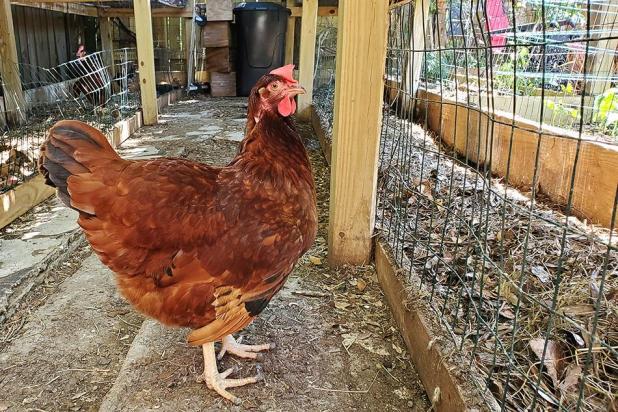
Rhode Island Reds are one of the most popular breeds of backyard laying hens. They produce brown eggs and can be raised in free-ranging systems or in a coop. The bigger the breed the more eggs layed.
—LSU AgCenter/Chris Dunaway
Preparations important for raising chickens
BATON ROUGE — With extra time at home, many people have begun raising chickens for the first time, while others are considering this rapidly burgeoning hobby. For those contemplating backyard chickens, it’s important to consider the materials you will need and how to keep both poultry and people healthy and safe.
During spring, you can purchase chicks — typically two to three days old — at many feed and seed stores. They’re also available through mail order from hatcheries.
“If you’re looking for a good egg-producing bird, go for the heavy breeds — like an Australorp, a Buff Orpington or a Barred Rock,” said Anna Timmerman, LSU AgCenter extension agent in Greater New Orleans. “Chickens also come in bantam size, too, which is a miniature. But if you’re looking for a good egg-producing bird, go for the heavier breeds.”
Before bringing baby chicks home, you need to set up a brooder area.
“You want good bedding material like pine wood chips in the bottom of the brooder so they don’t slip and go lame,” Timmerman said. “You also want to get chick-sized feeders and waterers.”
Additionally, young birds will need a sack of special chick starter feed, which has more protein than other feeds, grit for grinding their food and a fire-safe ceramic heat lamp that should be set to about 95 degrees.
“If your chicks are bunched up underneath the heat source, it’s too cold. And if they’re all out towards the edges, it’s too hot,” said Timmerman, who grew up raising poultry as part of a 4-H project. “If they’re all over the place in the brooder, then it’s just right.
“In about six weeks, they’ll look like full-grown birds.”
Susceptibility to extreme temperatures is not the only vulnerability for a chick or a full-grown chicken. Predators like foxes and coyotes are a constant threat, and the best way to prevent harm to your birds is by building a sturdy house that prevents multiple entry points.
“Most people think chicken wire is what you’re supposed to use for your building, but the gaps are big enough for predators to stick their paws through or rip it open and get your chickens. So you should use something sturdier with less openings,” said Matt Faust, a Baton Rouge resident who has been raising chickens for 10 years.
“It’s also important to sink concrete blocks under the structure to prevent predators from digging underneath the cages to get in,” he said.
“There are pre-fab chicken house kits you can easily put together that have two levels and a good roof,” Timmerman said. “You need protection from the rain and the elements, and the cage needs to be sturdy to keep them safe from predators.”
“As far as the health of the birds, keeping the cage dry and clean is about the best thing you can do,” Faust said. “If you don’t have a good roof on your cage and water is getting in all the time, it will become a slop hole of bacteria.”
Two of the most common chicken diseases that can spread from bird to bird and even destroy a flock are avian influenza and virulent Newcastle disease. Even though proper sanitation goes a long way in preventing disease, you can do something else first.
“The National Poultry Improvement Program certifies qualified poultry breeders to have chicks, hatching eggs or mature stock that are free of disease,” Timmerman said. “If you buy these NPIP birds, you’ll know they’ve already been vaccinated against diseases.”
People are also at risk of getting diseases like salmonella from handling poultry if they don’t use proper sanitation.
“You always want to wash your hands after handling your birds. And don’t kiss them or touch your face to them,” Timmerman said.
The U.S. Department of Agriculture recommends these safe cleaning tips for poultry:
—Regularly remove used litter, manure and other debris.
—Remove chickens from houses when “wet” cleaning all surfaces. Work from top to bottom and
back to front. Rinse carefully with water.
—Apply disinfectant according to label directions. Use disinfectants that the U. S. Envir-onmental Protection Agency indicates are effective against avian influenza and other poultry diseases.
—Leave the enclosure empty until it is completely dry. Wet surfaces can be harmful to poultry.
—Wash your hands thoroughly with soap and water after you leave the poultry area.
“People might think chickens are noisy and stinky, but as long as you do it properly, they’re not,” Faust said. “Chickens offer a lot of practical benefits. And because they’re really affectionate little animals, they make surprisingly good pets.”
